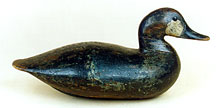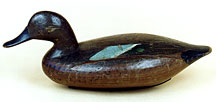by C. John Sullivan Jr.
For years ago the Kiwanis Club held a decoy show in Newark, Delaware, one of the first venues that served the interest of this just blossoming field of collecting. While attending the show in October 1966 my friend Henry Fleckenstein Jr. and I had an opportunity to
view a bushel basket full of what seemed to be historic Susquehanna Flats teal decoys. Initially it appeared that we had struck the mother lode, a rare treasure for collectors of Upper Chesapeake Bay decoys. But upon closer inspection those imposters were
recognized as brand new, antiqued copies of the rarest of the rare, teal decoys from the Upper Chesapeake Bay.
Joel Barber wrote in his seminal book, "Wild Fowl Decoys," published in 1934, that "in addition to Swan decoys another rarity among the host of American stool ducks is the Blue and Green winged teal." William Mackey lamented in his book, "American Bird Decoys," published in 1965, that teal decoys "all to (sic) rarely turn up on the Chesapeake." It was this lack of availability that obviously led to fakes invading the antique decoy marketplace. But what Chesapeake wildfowler would ever have dreamed that, one day, greedy forgers would be turning out copies of objects to lure collectors that were once used only to lure wary fowl?
 While few collectors had been exposed to forgeries at that time, and although they were carved as precise copies, the technology available to age paint in 1966 was not widely known. The frauds were painted with latex or acrylic paint that easily peeled from the While few collectors had been exposed to forgeries at that time, and although they were carved as precise copies, the technology available to age paint in 1966 was not widely known. The frauds were painted with latex or acrylic paint that easily peeled from the
bodies. But now several decades have passed, and recently a couple of the decoys from the same bushel basket turned up at a small auction in Maryland, 34 years later. Time and weather had aged the pair sufficiently that they brought inflated prices, high enough that one would assume that the buyer had the false image that he was purchasing legitimate waterfowling artifacts. A sad fact indeed.
That early experience, and the recent reminder of it, has made me ever vigilant in my search for the genuine article. Determined to turn up authentic historic gunning teal, I have searched every possible antique show, antique shop, boat house, loft and shed to uncover that rare species, but through all those years and among the thousands of decoys I have located, no more than 20 have been a diminutive teal. Few were ever made and fewer yet have survived. I once left a former canning house in Aberdeen, Maryland with six wonderful blue-winged teal carved in Havre de Grace in 1929 by Robert F. McGaw, but those are of a later generation than the truly great and early Susquehanna Flats teal. Over the years some teal "changed" species, their true identity now hidden under a coat of paint as a bluebill or ruddy. But savvy collectors can still recognize them.
 Of the migrant waterfowl, the teal arrive from the North earliest in the season, making their first appearance on the Upper Chesapeake in early September. The September 14, 1871 edition of the Baltimore Sun reported on its front page that "Blue-Wing Ducks and Reed
Birds, Bay Mackerel, Taylors, Trout, Rock, Perch and other Fish" were available for sale at the market of S.R. Scoggins on Hollingsworth St. in downtown Baltimore. In the Maryland Academy of Sciences’ publication, " A List of the Birds of Maryland," the following accounts of the blue-wing’s arrivals were noted: "A bunch of 15 were noted in Bear Creek, on August 20" of 1893, and on September 17, 1893, "a bunch of 10 on Loch Raven, in Dulaney’s Valley…evidently they had just arrived from the north and were tired out." Of the migrant waterfowl, the teal arrive from the North earliest in the season, making their first appearance on the Upper Chesapeake in early September. The September 14, 1871 edition of the Baltimore Sun reported on its front page that "Blue-Wing Ducks and Reed
Birds, Bay Mackerel, Taylors, Trout, Rock, Perch and other Fish" were available for sale at the market of S.R. Scoggins on Hollingsworth St. in downtown Baltimore. In the Maryland Academy of Sciences’ publication, " A List of the Birds of Maryland," the following accounts of the blue-wing’s arrivals were noted: "A bunch of 15 were noted in Bear Creek, on August 20" of 1893, and on September 17, 1893, "a bunch of 10 on Loch Raven, in Dulaney’s Valley…evidently they had just arrived from the north and were tired out."
The strong evidence of the teal’s early arrival date lies in the paint pattern used on these decoys. The paint mimics the eclipse phase of the male plumage. The males are slow in molting the female-like colors, which they assume in summer before shedding their wing feathers. They become temporarily flightless. The blue-wings do not take on full normal body plumage until December, while the drakes of most fowl have attained it by the end of September. Susquehanna Flats teal decoys from the late 19th and early 20th century that still wear their original paint all appear in the female-like colors.
Not all decoy makers from the Upper Chesapeake made teal. Many carvers created only the most popular species of the region: canvasbacks, redheads, bluebills and occasionally black ducks and mallards. But for those who made teal, some are precise miniatures of their larger decoys. In Havre de Grace both John "Daddy" Holly and his son, James T. Holly, made beautiful teal. Compared with a Holly pintail hen, their inspiration will show. Charles T. Wilson, a schoolteacher and public office holder, created some exquisite examples, including a fine example presently in the Shelburne Museum collection. Those early makers produced the majority of their decoys from 1850 to 1920.
 Following in their tradition, Robert F. McGaw carved teal in the 1920s and 30s. A few examples of James T. Holly teal have been found in what appears to be original McGaw paint. Joel Barber reported in "Wild Fowl Decoys" that he discovered his Wilson teal (the one presently at Shelburne) on a shelf in a small storeroom at the rear of McGaw’s shop. Cooperation and sharing most certainly existed among early decoy makers in such tight knit communities as Havre de Grace. Following in their tradition, Robert F. McGaw carved teal in the 1920s and 30s. A few examples of James T. Holly teal have been found in what appears to be original McGaw paint. Joel Barber reported in "Wild Fowl Decoys" that he discovered his Wilson teal (the one presently at Shelburne) on a shelf in a small storeroom at the rear of McGaw’s shop. Cooperation and sharing most certainly existed among early decoy makers in such tight knit communities as Havre de Grace.
Across the Susquehanna in Perryville, Benjamin Dye made teal decoys from 1850 to 1890. A close inspection of the available examples shows a close resemblance to his redhead decoys. During the same period in Charlestown on the North East River in Cecil County, John B. Graham was making beautiful decoys; he obviously relied on his mallard design when fashioning his pattern for a teal. Another Charlestown maker, Scott Jackson, made a small group of racy and magnificent teal. All of the known examples were discovered in the mid-1960s at an antique show in Baltimore County. Each was painted identically in what could only be described as 1920 Packard maroon.
In addition to the well-known decoy makers of the region, some yet unknown carvers fashioned beautiful teal. One stylish example was undoubtedly made by the same hand as a black duck in my collection. Their profiles are identical. While some collectors may refer to Upper Bay teal as "cute," that term would better describe a Susquehanna Flats ruddy duck. The teal decoys are diminutive but stylish, the longest measuring a mere 11 ½ inches from the tip of the bill to the tip of the tail.
As scarce as the wooden teal from the Upper Chesapeake Bay have become, it must be all of our hopes that the live ones have not become as scarce at our hands. "Have you ever shot one," some will ask, as though shooting one would somehow increase one’s knowledge of the wooden fowl. Yet while considering the rarity of these stylish but diminutive lures, the elusive Susquehanna Flats teal, how many have you seen?
For the complete story, please see the Sept./Oct. 2001 issue of Decoy Magazine.
Tidbits Main Index

|


